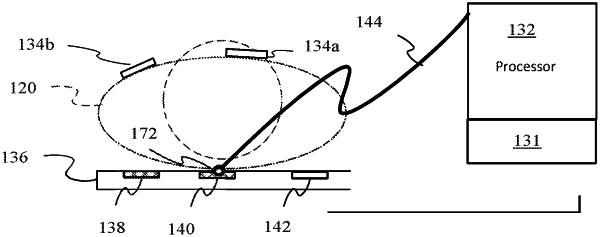| CPC A61H 31/005 (2013.01) [A61H 31/007 (2013.01); A61H 2203/0456 (2013.01); A61H 2205/084 (2013.01)] | 19 Claims |

|
1. A defibrillator, comprising:
transmitters configured to transmit ultra-wide band (UWB) signals into a patient;
defibrillation pads configured to be disposed on the patient and to reflect the UWB signals;
receivers configured to receive the UWB signals that have been reflected by the defibrillation pads;
an output device;
a processor; and
memory storing instructions that, when executed by the processor, cause the processor to perform operations comprising:
determining times-of-flight of the UWB signals between the transmitters and the receivers;
determining positions of the defibrillation pads based on the times-of-flight of the UWB signals; and
causing the output device to output an instruction to change the positions of the defibrillation pads.
|
|
4. A defibrillator, comprising:
a transmitter configured to wirelessly transmit a signal into a patient;
a defibrillation pad configured to be disposed on the patient and configured to reflect the signal;
a receiver configured to receive the signal that has been reflected by the defibrillation pad;
an output device;
a processor; and
memory storing instructions that, when executed by the processor, cause the processor to perform operations comprising:
determining a time-of-flight of the signal between the transmitter and the receiver;
determining a position of the defibrillation pad based on the time-of-flight of the signal; and
causing the output device to output an indication of the position of the defibrillation pad.
|
|
13. A method, comprising:
wirelessly transmitting, by a transmitter and into a patient, a signal that is reflected by a defibrillation pad;
receiving, by a receiver, the signal;
determining a time-of-flight of the signal between the transmitter and the receiver;
determining a position of the defibrillation pad based on the time-of-flight of the signal; and
outputting, by an output device, an indication of the position of the defibrillation pad.
|